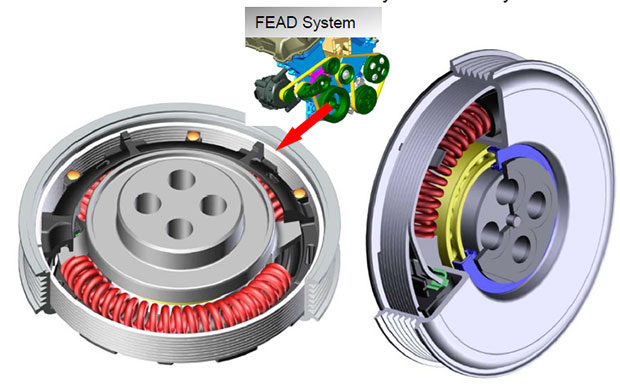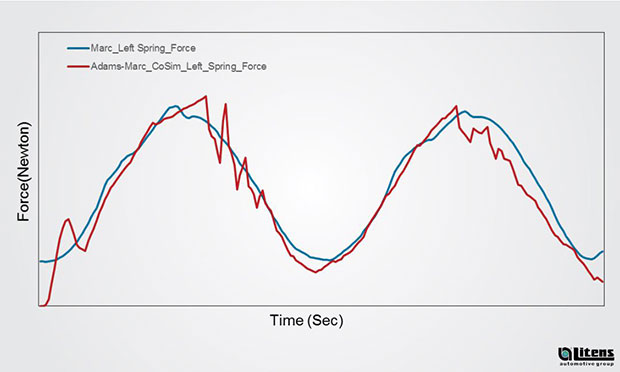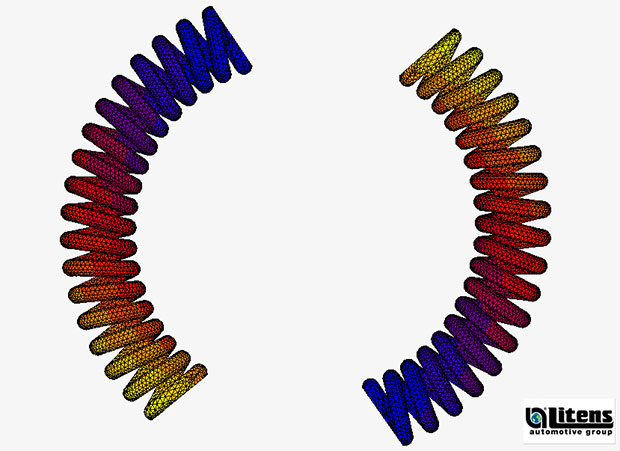
The Litens torque modulator controls the system resonant frequency by tuning the spring stiffness to the system inertia. Image courtesy of MSC Software.
Latest News
April 1, 2015
 The Litens torque modulator controls the system resonant frequency by tuning the spring stiffness to the system inertia. Image courtesy of MSC Software.
The Litens torque modulator controls the system resonant frequency by tuning the spring stiffness to the system inertia. Image courtesy of MSC Software.Litens Automotive Group’s patented TorqFiltr torque modulator uses an arc spring isolator mechanism to decouple the accessory drive system inertia from the engine torsional vibrations. The Litens torque modulator controls the system resonant frequency by tuning the spring stiffness to the system inertia. Because the spring stiffness is softer than traditional rubber isolators, vibrations from the engine are mostly absorbed before being transmitted to the accessory drive belt. This results in isolation of all components in the accessory drive, and any accessory drive resonance has very small peak amplitudes, since there is very little excitation.
The product is dimensionally rather small, but incorporates a complex mechanism consisting of a series of components that transmit power to each other through complicated frictional contacts rather than fixed connections.
“This device provides an enormous design challenge,” said Steve Jia, chief engineer for Litens Automotive Group. “We need to fully understand the behavior of the design under dynamic loading conditions. The product must be customized to deliver optimal performance for many different automotive engines. In the past, this involved a time-consuming and expensive trial and error process.”
Challenge
Simulation provides substantial cost savings by accurately predicting performance of a proposed design without the considerable expense and lead time required to build and test a prototype. However, the computational resource requirements are considerable because a nonlinear finite element analysis (FEA) is performed on each component. The time to perform a typical simulation is 30 hours, which limits the degree to which nonlinear analysis can be used in the design process.
With MSC Software’s Marc nonlinear FEA platform, Litens developed the ability to accurately simulate the operation of its torque modulator — including how the design behaves, how components move and react against each other and what happens under dynamic loading conditions
“We were looking for an approach that would allow us to simulate the performance of our torque modulators, including material and geometric nonlinearities, in a fraction of the time so that we could integrate advanced nonlinear analysis into the design process,” Jia says. “We had the idea of combining multibody dynamics (MBD) simulation at the system level with nonlinear finite element analysis at the component level for components with large deformation to achieve a fast solution and accurate results.”
MBD software has previously been integrated with linear FEA software, but not with nonlinear FEA, which is needed to provide accurate results for components with large deformations and material nonlinearities, such as the right and left side springs used in the torque modulator.
Solution
“MSC is the leader in nonlinear analysis with Marc and the leader in MBD software with Adams, so they were the obvious choice to approach with our request to integrate these two technologies,” Jia says.
MSC engineers coupled Marc and Adams so that the interaction between the motion behavior in Adams and the nonlinear behavior in Marc is taken into account in the simulation at both the system and component level and solved at each integration time step. Deflections calculated by Adams are taken into account at each time step in Marc and dynamic loading conditions are transferred from Marc to Adams. Marc determines stress and deformation at the component level with geometric, material and contact nonlinearities taken into account.
The Adams-Marc co-simulation capability was introduced in a beta release of Adams 2014. The beta release was validated on the Litens torque modulator before the software was released to the general public in Adams 2014.
Results
Litens’ CAE engineers set up the typical simulation so that only the left and right springs are modeled as flexible bodies in Marc and all other components are modeled as rigid bodies. Six contact points are established between the shell of the torque modulator and the springs, and these points are used by Adams to provide displacements to Marc, and by Marc to provide forces back to Adams.
Under these conditions, Adams-Marc co-simulation analyzes the torque modulator in only two hours, 1/15 of the time required for Marc simulation. A small difference of 10% in results was seen with co-simulation, and this was expected since normal Marc simulation analyzes all components as flexible bodies while the co-simulation models most components as rigid bodies.
The Marc simulations have previously been found to be very close to physical measurements. The co-simulation results for key values, such as the inner drive angle as a function of input torque, were found to vary by less than the 10% from the Marc simulation over two revolutions of the input shaft.
 Comparison of dynamic spring load for left spring for Marc simulation vs. Adams-Marc co-simulation. Image courtesy of MSC Software.
Comparison of dynamic spring load for left spring for Marc simulation vs. Adams-Marc co-simulation. Image courtesy of MSC Software.“This small difference in results is acceptable considering the dramatic reduction in computation time provided by co-simulation,” says Jia. “This technology will make it possible for the first time to utilize advanced nonlinear FEA as an integral part of the design process. We see this advancement as similar in significance to the advancement several decades ago in computing power, which made it possible to integrate FEA into the design process. It is expected that Adams-Marc co-simulation in the early stages of the design process to evaluate different design alternatives will significantly speed up the design process. Once we find a design that looks promising, we will run a more accurate Marc simulation to validate its performance.”
More Info
Subscribe to our FREE magazine, FREE email newsletters or both!
Latest News
About the Author
DE’s editors contribute news and new product announcements to Digital Engineering.
Press releases may be sent to them via [email protected].







